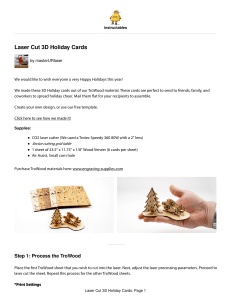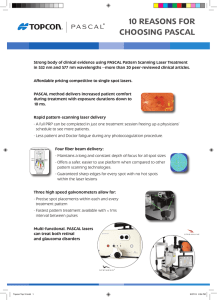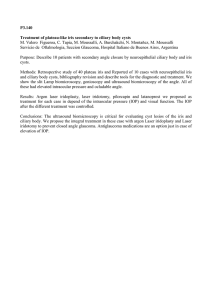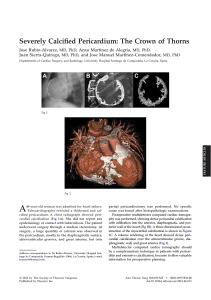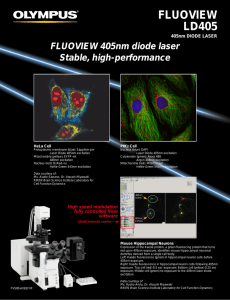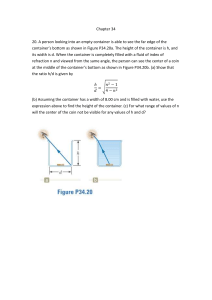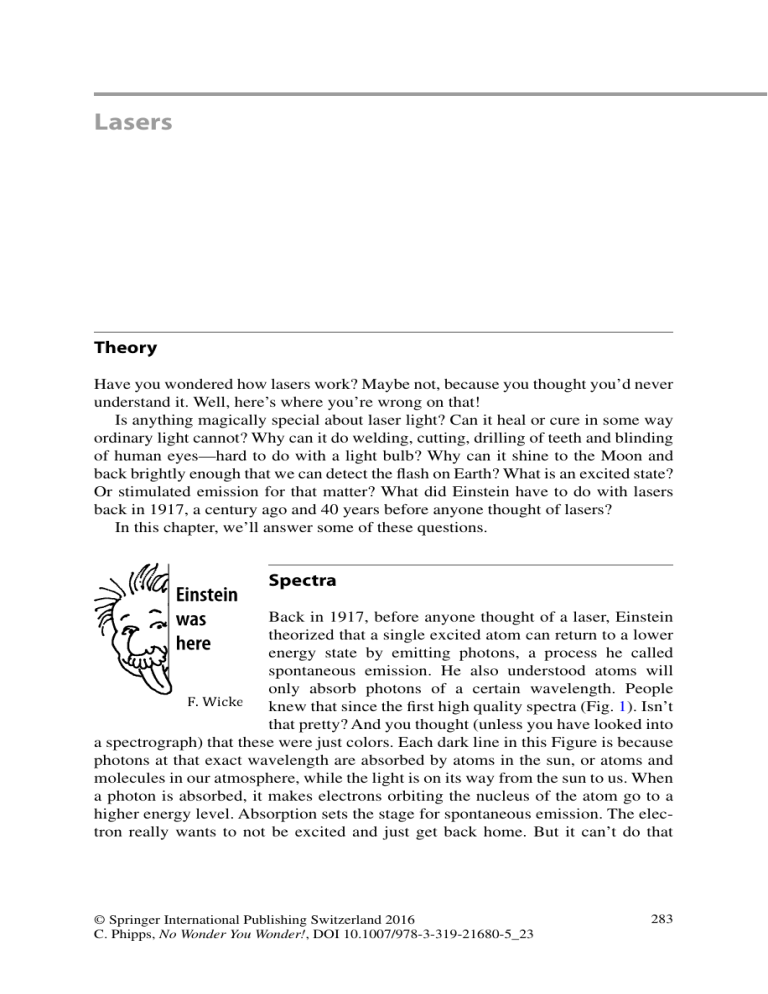
Lasers Theory Have you wondered how lasers work? Maybe not, because you thought you’d never understand it. Well, here’s where you’re wrong on that! Is anything magically special about laser light? Can it heal or cure in some way ordinary light cannot? Why can it do welding, cutting, drilling of teeth and blinding of human eyes—hard to do with a light bulb? Why can it shine to the Moon and back brightly enough that we can detect the flash on Earth? What is an excited state? Or stimulated emission for that matter? What did Einstein have to do with lasers back in 1917, a century ago and 40 years before anyone thought of lasers? In this chapter, we’ll answer some of these questions. Spectra Back in 1917, before anyone thought of a laser, Einstein theorized that a single excited atom can return to a lower energy state by emitting photons, a process he called spontaneous emission. He also understood atoms will only absorb photons of a certain wavelength. People knew that since the first high quality spectra (Fig. 1). Isn’t that pretty? And you thought (unless you have looked into a spectrograph) that these were just colors. Each dark line in this Figure is because photons at that exact wavelength are absorbed by atoms in the sun, or atoms and molecules in our atmosphere, while the light is on its way from the sun to us. When a photon is absorbed, it makes electrons orbiting the nucleus of the atom go to a higher energy level. Absorption sets the stage for spontaneous emission. The electron really wants to not be excited and just get back home. But it can’t do that © Springer International Publishing Switzerland 2016 C. Phipps, No Wonder You Wonder!, DOI 10.1007/978-3-319-21680-5_23 283 284 KH Lasers h g Gf e 390 400 d 450 h F c h b 4-1 D E 500 3-1 550 C a B A 650 600 700 750 wavelength in nm Fig. 1 Absorption lines in the sun’s spectrum (Public Domain) incoming Photon absorbed by the Atom higher-energy Photon emitted Nucleus incoming Photon absorbed by the Atom Nucleus lowest-energy level lowest-energy level lower-energy level lower-energy level excited state excited state lower-energy Photon emitted Fig. 2 Absorption and emission (F. Wicke) instantly for various reasons. It may be that it can’t go down instantly because that’s a “forbidden transition” [Sounds exciting, no?]. Or it just takes a while for other reasons. When it does come down by itself, that’s called fluorescence. If you still remember those, you know from the numbers on a watch dial glowing in the dark fluorescence can take hours. Absorption Oh. Did I say higher energy level (Fig. 2)? Sounds a little new-agey, huh? An atom’s electrons (and therefore the whole atom) are in different energy levels according to their distance from the positive protons in the nucleus, and some other details of the orbit itself. Just as a manmade satellite has to fight against gravity to get into orbit, the electron has fought against the electric field of the nucleus, if it has risen to an excited state. Chemistry 285 Quanta There’s only one difference, and it’s an important one. As people like Planck and Bohr showed, thinking about those sharp lines in Fig. 1 spectrum, tiny things can’t have just any energy, but just certain precise ones (quanta)! This is hard to understand at first, and it was for them. The energy that you or a satellite have is also quantized, but the number of quanta is so big that the difference from one to the next is too small to matter. In an atom, that’s no longer so. Photons also have a very precise energy, and it’s a universal constant h called Planck’s constant times the photon frequency ν. The bluer it is, the higher ν is, and vice versa [Check out Table 1 of EM Waves]. Frequency is just the speed of light divided by the wavelength λ. Absorption is mostly [never say only!] going to happen if that photon has precisely the energy needed to raise a particular electron in a particular atom from one orbit to the next and, to repeat, that is a precise energy. So: the frequency (color) of the photon that is absorbed by a particular atom is precise, too! That’s why those lines in Fig. 1 are narrow and black: the electrons in those atoms suck out all the light of a particular color. Each atom has its own fingerprint of “lines.” So: if you know the atoms pretty well, when you see a group of absorption lines, you can say “Aha! That’s sodium!” (Or beryllium, or iron 17 times ionized! It does get complicated!) How can we use that? The “ChemCam” on the Mars Rover, developed by Roger Wiens of Los Alamos and 78 other folks from all over the world, shoots a laser at a rock, looks at the spectrum and tells what it is! Isn’t that amazing? So: back to our electron fighting its way up. It can fight in many ways: by absorbing a photon, by being hit by an electron beam from outside, by colliding with another excited atom, or by just getting very hot, as examples. Chemistry Electrons all have their homes in the atom. In hydrogen, it’s pretty simple (one electron, one home). In a more complex atom like oxygen (Fig. 3), the natural state is two on the inside and six more in the next orbit up. For reasons you’d be bored with, the first orbit is full when it has two electrons, and the second orbit is full when it has eight electrons. But oxygen has only 8 plus charges in its nucleus, so it can only have 8 electrons, not its full 10, and it is unsatisfied all the time. To be satisfied, it would need 10 plus charges in the nucleus. It would then have a complete outer shell—but it would be neon, not oxygen (Fig. 4). Because it’s complete, neon doesn’t normally react with anything chemically speaking, and it’s called a noble gas. 286 Lasers Fig. 3 Oxygen atom (F. Wicke) Fig. 4 Neon atom (F. Wicke) I can’t help digressing for a moment to mention that we living things are so lucky that oxygen is like it is, hungry. It just wants to get two more electrons and the positive charges that would hold them, to be happy. How can it do that, short of a thermonuclear reaction? It cheats! If it can snare a couple of electrons belonging to an atom that burns (hydrogen for example), those atoms bring the plus charges with them, and the oxygen feels complete and understood. Figure 5 shows how this works with water. Can you imagine the world without water? Oxygen also combines Emission 287 Fig. 5 Water (F. Wicke) with lots of other stuff, like carbon. Then you get CO2, warmth around campfires for millions of years, the Industrial Revolution—but also climate change when you burn too much too fast. Or you get rust when you leave iron out in the weather. Emission An excited electron can dump that extra energy randomly (“spontaneous” emission). But it can’t make the final transition and crash right into the nucleus. Why? We talk about that in Weird Reality. It’s not obvious! Or (an important “or”) if a stray photon at the correct wavelength just happens along [incoming orange photon in Fig. 6], Einstein guessed in a genius moment that it can stimulate the atom to release its photon instantly. This does not destroy the incoming photon. After this, those two photons will travel in the same direction with the same frequency and phase as the original stray photon (Fig. 7). As I say in the Weird Reality chapter, an old girl friend thought “stimulated emission” a funny name for this process. Another way to say it is that photons like to travel together, and in the same state. Doesn’t that sound cozy? This is important for what a laser can do. This is genius—and there are a lot of things that come out of that preference! “Same phase”? That just means they’re both experiencing the same part of the rise and fall in the electric/magnetic wiggle that constitute Electromagnetic Waves at the same time. 288 Lasers Fig. 6 Stimulated emission (F. Wicke) Fig. 7 A boxful of excited atoms is a laser! (F. Wicke) Oh, ahh—where did the electrons go in Fig. 6? We are so used to thinking of them as tiny dotlike things whizzing around the nucleus. Now, we’re going to wean you from that idea. I’m here to tell you it’s a probability cloud and not a thing at all [see Weird Reality]. Not only that, like I suggested earlier, the distance from the nucleus is not the only unique property an electron has in an orbit. That electron wave can have different distinct ripples in its shape around the nucleus, as well as different “spins,” and those differences put a limit on the number of electrons in an orbit, as well as slightly different energies. Electrons don’t like very close neighbors, but photons do! The biggest division in the physical world is between these two personalities, the ones that like intimacy and those that don’t. These are bosons and fermions. We won’t go into that deeper here. Start of the Laser Age 289 The Laser Idea Now, there are two photons! You can see from Fig. 6 that one photon becomes two. Two then become four, then eight … (Fig. 7). Does this remind you of Rani and her grains of rice? It should! [see Exponentials]. What happens in a boxful of excited atoms that have all been pumped up into a higher energy level and are all just waiting to be stimulated? Wow! At the speed of light, you’ve suddenly got a huge wave of photons of the same color moving in the same direction and sweeping up all the available energy in that boxful of atoms! From one photon to enough energy to burn something in millionths or billionths of a second! That’s all there is to a laser! Inversion You may think some of your friends are inverted, right? Well atoms get that way too when for one reason or another there are more electrons in a higher state than in a lower state. This does not happen by accident—just getting hotter won’t do it, because however hot it gets, there will always be more in the lower energy state than in the upper. That’s just the way it is. But if I come along and pump the atom with an intense stream of high energy photons, or an electron beam, or a chemical reaction, I can make a “population inversion,” where momentarily there are more electrons or molecules in the upper than in the lower state. You can understand that an inversion is necessary to make a laser. By the way, it’s easier if your atom has an upper state where the electron gets “stuck,” in a “metastable” state so that the transition back down is “forbidden,” until it’s stimulated. Not all lasers are atomic. Start of the Laser Age The question is, why did it take 40 years after Einstein for physicists and engineers to make a laser? Townes, Schawlow, Javan, Maiman … in the late 1950s, just as Elvis was very hot, all these guys suddenly thought of it, and some did it, at the same time. I’m not sure about the answer to my question, but I think it was because people couldn’t think of a way to make an inversion. All these guys thought about it, but in 1960, Ted Maiman at Hughes Research in Malibu went into the lab and did it! He built the first ruby laser, and it could burn the emulsion off a photograph in one loud pop. He used a pink ruby surrounded by a coiled flashlamp from G.E. (Fig. 8). The flashlamp made the inversion, and the ends of the rod itself acted as mirrors to bounce the light back and forth through enough distance for Rani and her grains of rice to go from one photon to maybe ten billion billion. In those days, the output was a series of spikes rather than a single giant pulse—but it was done! On the far wall Ted saw a pink spot. 290 Lasers Fig. 8 The first laser (Guy Immega, Wikimedia commons) Fig. 9 Focusing bright light (C. Phipps) Among Americans, theoretical physicist Charlie Townes got the Nobel for the laser. The Russians Basov and Prokhorov shared it. Not Maiman, who did it first, or Javan, who made the first gas laser. Go figure. The Laser Zoo From these humble but courageous beginnings, there are electrically driven gas lasers (CO2, helium-neon), chemical lasers, solid crystal lasers—even the atmosphere of Mars has been accused of being a laser. Some of them are monstrous, like the 100TW NIF neodymium:glass laser (see later). Some are tiny glass fibers with lasing cores smaller than a hair. Some are little laser diodes that can make jets The Laser Zoo 291 Table 1 The Laser Zoo Solid crystal Lasant Er3+ Host Glass, YAG Wavelength (nm) 1500, 2900 Cr3+ Ruby 694 Ti3+ Sapphire 700–1000 Nd3+ Glass, YAG Glass, YAG – 1065 Yb3+ 1065 Semiconductor GaAs, InGaAs 780–905 Gas H2O – CO2 – 0.028, 28,000, 220,000 9200–11,400 OI – 1315 HeNe – 633 Cu Ar Kr XeF XeCl KrF ArF F2 – – – – – – – – 578 458, 476, … 502 416, 458, … 799 351 308 248 193 157 Noted for Many wavelengths: 2.9 μm is “eyesafe” (eye lens won’t transmit it), 1.5 μm is for optical fiber communication. First laser. Few joules of energy pulsed Huge bandwidth makes it suitable for ultrashort pulses Can be CW or pulsed. Mainly noted for giant energies. Same apps as Nd:glass Semiconductor laser diode. Tiny, tens of mJ pulsed, tens of W CW. Main use in communication and laser pumps. Yes, water (vapor) can lase! W to tens of kW CW. Used for welding and cutting. CW, oxygen-iodine chemical laser, MW power. Helium-neon laser, Javan’s discovery, tens of mW CW. Good for alignment, surveying. Copper vapor does the lasing. Tens of W of CW power Tens of W of CW power “Excimer.” Hundreds of J pulsed. “Excimer.” Hundreds of J pulsed. “Excimer.” kJ pulsed. “Excimer.” Tens of J pulsed. “Excimer.” Tens of J pulsed. to push spacecraft. Some are “excimers,” momentary compounds like XeF or KrF that ought not to exist. Table 1 lists some laser types you might be interested in. Terminology: YAG: yttrium-aluminum garnet, GaAs: gallium arsenide, InGaAs: indium gallium arsenide, Er: erbium, Yb: ytterbium, Nd: neodymium. Did you even know those last ones were elements? Excimers include XeF: xenon fluoride, XeCl: xenon chloride, KrF: krypton fluoride and ArF, argon fluoride. Lasant means what lases, host is the crystal in which it is embedded for crystal lasers. Then, there are molecular lasers. In CO2 for example, energy levels come from different molecular stretches and bending, which I won’t drag you through here (Fig. 10). There are also x ray lasers from 3.5 to 45 nm. Too much detail? Here’s a visual: Fig. 10 The laser spectrum (Danh, Wikimedia Commons) 292 Lasers Ultrashort Pulses 293 What’s Special About Laser Light? 1. It’s very bright because the mirrors on each end of a laser oscillator make the light go in one direction, the same as that first stimulating photon. 2. It is usually just one color (except when it’s not, as in the Ti:sapphire laser we talk about in the next section. What do these features let us do? (Fig. 9) Because the light rays are parallel, a good lens can focus them to a spot with diameter as small as a wavelength of light! If that is 1 μm, and we have just 1 W of power, the intensity at the focus is 100 MW/cm2! You can use this feature to cut, weld, or do laser fusion, where you are trying to create temperatures of hundreds of millions of degrees, like in the very center of the Sun! You can make welds inside a tube, or very fine and intricate patterns on solid materials, like integrated circuits. You can’t focus an ordinary light source—even the Sun—like that. Ordinary light comes from a hot filament or an electric arc, in any case something with a hot surface at temperature T putting out rays in all directions. Thermodynamics says there is no way I can focus that to produce a temperature higher than T! If I could, then heat would go back from my focus to its source making it hotter, and that would be ridiculous. So: a laser is brighter than the sun! Think about that. You can hurt your eyes. You can make a plasma [what happens when you make something hot enough to become the fourth state of matter, just ions and electrons]. You can use a laserproduced plasma for space debris removal. We’ll get into that later. The narrow linewidth can let us pick just one chemical reaction and make it go. As an example, for cancer therapy, we can inject something that binds to the cancer and also kills tissue when we put light of a certain wavelength on it (photodynamic therapy). Any wavelength won’t work. Just the one that starts that reaction. Ultrashort Pulses You can skip this section if it looks too hairy. Shorter, and shorter, and shorter pulses and more and more energy and colors (wavelengths) … this is the history of improvements in lasers. Maiman’s laser pulse was milliseconds in duration. First Q-switching, then modelocking took that to microseconds and then nanoseconds. To make an ultrashort pulse, you need an ultra broad bandwidth laser like titanium-sapphire. That’s because the uncertainty principle says it’s so [see the section on uncertainty in Weird Reality]. Up to now, I’ve been talking about precise, narrowband transitions in single atoms. When the laser is an impurity ion in a crystal, it’s more complicated. The ruby laser is aluminum oxide crystal with a few percent chromium atoms that get three times ionized just by being in the crystal. The Cr3+ ion is the lasant. 294 Lasers Fig. 11 Kerr lens modelocking (Creative Commons license) Titanium sapphire is an aluminum oxide crystal with Ti3+ ions replacing aluminum atoms, instead of Cr3+. In the crystal, there are powerful electric fields that hold the ion in place. So powerful that they can change the laser frequency depending on the distance of the impurity ion from the nearest oxygen atoms in the crystal structure—and that can change because of crystal vibrations. Because of this, Ti:sapphire can lase from 700 to 1000 nm wavelength, let’s say 850 ± 25 %! In a very short pulse, this beam will have more than all the colors of the rainbow—if you could see out to 1000 nm in the red. That center wavelength corresponds to 350 THz and the 50 % bandwidth corresponds to a pulse only 5 fs long! It takes that much bandwidth to make a pulse that short. In such a short time, light only travels 0.3 μm. But how do you get that short pulse? One way is a brilliant invention called the Kerr lens modelocker. Laser beams are stronger in the center and weaker at the edges (Fig. 11). In the Figure, “CW” just means low intensity, and “Kerr medium” means something which causes a very intense beam to focus itself, because the refractive index increases with intensity. That can happen in femtoseconds, allowing a pulse that short to get out of the aperture. The actuality is a little more complex with multiple mirrors on both ends. This is a fs oscillator, and it will have a pretty small energy. Now how do we get a lot of energy in a short pulse? With an amplifier, duhh! But how do I do that without more self-focusing? Gérard Mourou invented chirped-pulse amplification in the 1980s to solve this problem, and that has given us tens of joule amplified beams down to a few femtoseconds width, and that means petawatts! The secret here is just to reduce the intensity by spreading the beam in time while you amplify it—so it won’t self-focus in the amplifier—then recompress it. How do you do that? We said it has all the colors of the rainbow, right? Have you seen a diffraction grating? You can arrange a pair of them in such a way that red colors get through quicker than blue ones (Fig. 12). What comes out is a million-times-longer pulse that is red at the front and blue at the back, with much lower peak intensity. That’s chirping. Now you amplify the beam. Then you put it through a pair of gratings arranged so the reverse is true and you have your powerful femtosecond pulse! I admit it’s complicated. Digression: Bats and Chirped-Pulse Acoustic Radar 295 Fig. 12 Chirped pulse amplification (US Department of Energy—Public Domain) Fig. 13 A bat (Oren Peles, Wikimedia Commons) Digression: Bats and Chirped-Pulse Acoustic Radar This is the same thing bats do (Fig. 13). They use acoustic radar, and they can locate little mosquitoes and so on 1 mm in size. But at the speed of sound in air, that’s a few microseconds, and the bat can’t make so short a click. What does he do? He 296 Lasers chirps and then reformats the chirped echo from a mosquito using a dechirping circuit in his ears and brain so that he registers a click. This is all at frequencies we can’t hear, so you aren’t aware of it. But in South Africa, I’ve heard bats that chirp in the audible range. Petawatt Pulses, Attosecond Lasers Several labs around the world have now made beams with 30 J in 30 fs, which is 1 PW! If you focus that to a square wavelength of light, you’ve got 1E23 W/cm2, a truly astronomical number. You can circularly polarize that beam, split it and recombine it in a cloud of neon or xenon gas in such a way that the two beamlets only add up to a big electric field during one optical cycle, about 1.3 fs. The electric field of the light itself can be 10 GV/cm (see Electromagnetic Waves). This is 100 V across the size of an atom, and it only takes 10 V or so to ionize an atom. So, when that electric field hits the poor neon atom, it can strip an electron right off it, after which it comes crashing back down on the nucleus and— ¡bang! you have an attosecond pulse! That’s because acceleration is what makes a moving charge radiate, and hitting that nucleus is an extremely abrupt stop. Boy, this sounds complicated. So we’re going to leave it at this. Without getting into it deeper, 50 as is how short pulses are now! So OK what can I do with a 50as pulse? In such a short time, I can catch chemical reactions with their pants down, so to speak, literally take stop motion photos of every stage of a reaction, at 100 million frames a second, as someone recently did. Ohh—and a pulse that short must have an even broader bandwidth to exist, compared to Ti:sapphire, so it will be an x ray pulse! Applications Now that we’ve talked about some of the different types of lasers, let’s go to specific uses. Just like for our laser zoo, the story will go from low to high power, continuous to short pulses. Photodynamic Therapy (PDT) Figure 14 shows PDT being used. The patient has been injected with a light-sensitive drug that finds and binds to cancer cells. Then, the doctor uses an optical fiber to carry light of just the right wavelength from the laser to the cancer. What happens then is that the drug becomes a poison that destroys the tumor without damaging normal cells very much. Isn’t that amazing? Doesn’t work for all cancers, of course, brain cancer in particular, because the “blood–brain barrier” keeps the drug from getting from the blood to a brain tumor. Applications 297 Fig. 14 Photodynamic therapy (National Cancer Institute, public domain) Laser Engraving, Welding and Cutting Because of Fig. 9, focused light from a few-kW laser can get things very hot, or cut very finely. Laser engraving is faster. more accurate and more intricate than any other way. You can engrave wood, glass and stainless steel. In welding, if you put an inert gas like helium over your work, the laser isn’t adding any impurities as can happen with a gas or electric welder, and air can’t oxidize the hot surface. You can weld aluminum and steel together! These days, fibers can carry tens of kW of light to a workpiece and it’s easy to do this fast under robot control. The shell of your car is probably welded together this way. But where’s the laser light in Fig. 15? It’s invisible, has 12 kW of power, and it’s coming directly down on the workpiece from above, not through one of those nozzles. The big nozzle is bringing inert gas to the weld spot. The small nozzle blows away fumes. On the surface, you see a laser-produced plasma. Bear in mind that invisible beams are more usual than not—these days the most common laser welding and cutting beam will be 1.06 μm, from a diode-laser-pumped glass laser, and that’s about 50 % too far into the red for you to see. That’s why they’re dangerous. 3D Metal Printing Sometimes, laser welding is the only way to do it. For example, welding the inside of a tube. And you’ve all heard about 3D printing. This doesn’t use a laser, but just squirts plastic onto a mandrel according to a computer design. But if you want to make a drill bit with amazing properties, you can squirt a metal powder onto that mandrel and melt it with a laser, making 3D metal parts that can’t be made any other way. 298 Lasers Fig. 15 Laser welding (Krorc, Creative Commons license) Cornea Surgery If you need your cornea reshaped, microsurgery using an excimer laser is the way to do it. At those short wavelengths, the laser light actually lifts off (ablates) the cells on the inside of the cornea, so you get a new cornea shape without burning. Laser Gyros Next time you fly across the Atlantic, think about the fact that a laser gyro is telling your pilot where you are. Inertial guidance is one of the most ingenious, magical things mankind has invented: a device that stays pointed at the same spot in absolute space, even as the Earth turns underneath it and, with the help of computers, always knows exactly where it is. It’s GPS without the GPS! How would you use it? You know the exact locations on each end of the trip in three-dimensional absolute space. You select the destination, program it in and tell it to go. Another reason you would want such a thing? You’re going from the Earth to the moon, and there are no GPS stations. Also, unfortunately, since the days of the V2, ICBM’s have needed gyros to know where they’re going without external references that could be jammed. How does it work? There are two paths the light can go (Fig. 16): clockwise or counterclockwise around this loop. I never said a laser had to lase in one direction. Now, imagine the table underneath it is rotating clockwise. Each time a clockwise photon goes around, it takes a tiny bit longer than the counterclockwise photon to get to the same spot. This is because the goalpost (the detector behind the partial mirror) moved during the time the photon was going around! Applications 299 Fig. 16 Laser Gyro (C. Phipps) The difference is a fraction of a wavelength of light, but the detector can see that difference as the waves add and subtract. Believe it or not, these things can now detect 0.01° per hour rotation, and have a 60,000 h lifetime. Knowing the angles so well and the distance it traveled in three dimensional space (there are three mutually perpendicular gyros), the computer can compute where you are in absolute space, then subtract the rotation of the Earth in the meantime and say how far you are from Paris. Isn’t that amazing? Here is what one actually looks like (Fig. 17). Before this genius invention, people used very, very accurately machined spinning wheels. The mechanical gyros made for Apollo were designed and built at MIT’s Instrumentation Labs. I was privileged to be present May 25, 1961, when the I-Lab public address system broadcast President Kennedy’s announcement that we were going to the Moon. Everyone there knew how important that would be for the nation and for us. This thing was not perfect. It drifted about 0.05° per hour (five times worse than a laser gyro!) and had to be reset periodically by the astronauts 300 Lasers Fig. 17 Laser Gyro in operation (Nockson, Wikimedia Commons) sighting on a star. They chose Canopus, one of the brightest stars in the Southern Hemisphere. It didn’t matter that Canopus is hard to see in the USA; it was going to be easy to find between the Earth and the moon. Laser Produced Plasma Light intensity does stuff. You can shine a flashlight on a piece of paper at 1 W/cm2 all day and never see a plasma or anything else. Use a good lens to focus the sun on a piece of paper (1 kW/cm2) and you’ll make it flash into flame. Focus a 25 kW Nd:glass beam onto steel with a 2 mm focal spot (1 MW/cm2) and you’ll weld it. These are all continuous (not pulsed) light sources. If you have a pulsed laser, you can put just 100 mJ of energy in a 1 ns pulse on that same 2 mm spot and you will get a plasma, the fourth state of matter as temperature increases, after solid, liquid and gas. If you make a plasma jet on a surface with a pulsed laser, you get pressure, and that pressure pushes back on the surface. If the surface is a piece of space debris (Fig. 18), you can push it around. If you do it right, you can slow it down just enough that it will re-enter the atmosphere and burn up. If these pulsed beams are brought in from every direction around a sphere of DT (deuterium-tritium), then you compress it and make a miniature hydrogen bomb. We’ll visit all of this now. Orbital Debris Removal One of my favorite projects has been laser space debris removal. The laser beam has kW of power divided into a string of very high power short pulses that act like a machine gun pointed at the debris (Fig. 18). You can also put the laser in orbit, which now seems a lot easier way to do it than having the laser on the ground because you can work at closer distance without the air. Applications 301 Fig. 18 Laser Orbital Debris Removal (C. Phipps, Photonic Associates, LLC, by permission) Fig. 19 The Laser Plasma Thruster (C. Phipps, Photonic Associates, LLC, by permission) Laser Space Propulsion You can also use pulsed lasers to make a plasma jet on an object and drive it through space. Here is an example that uses semiconductor laser diodes shining on a piece of rolling tape like 8 mm movie film to make little jets. You can see the holes where the jets come out in Fig. 19. It weighs 1/2 kg, and makes just 10 mN using six diodes, 20 W of power and 30 m of fuel tape. 302 Lasers Pyramids of Cheops I hate to put it this way, and I mean no disrespect to the folks who have designed and built these facilities, but three laser applications are of a size that would have made a Pharaoh proud. The first of these is the National Ignition Facility in Livermore, CA, east of San Francisco and north of San Jose. NIF You want to see a really big laser? Figure 20 shows the very largest one in the world. A ten story building as wide as three football fields and 120 m long contains a huge Nd:glass laser with 192 beams and a vacuum target chamber 10 m in diameter. This is truly the Cheops Pyramid of laser science. Each of these is then frequency-tripled into blue light. The result is 192 blue beams with total energy of 1.9 MJ in 20 ns. That’s 100 TW! Every one of these go through different windows in the target chamber (Fig. 21) into the tiny container in front of the guy’s eye in Fig. 22, arriving at the same time within 30 ps, if you can imagine that. Right at the entrance to the gold cylinder, you get about 5 PW/cm2. Fig. 20 One of the two laser bays at NIF, the National Ignition Facility (US Department of Energy—Public Domain) NIF Fig. 21 NIF target container (US Department of Energy—Public Domain) Fig. 22 NIF target chamber being delivered (US Department of Energy—Public Domain) 303 304 Lasers Fig. 23 Spherical compression from laser-produced plasma (C. Phipps) Laser Fusion Dream Now here’s the point: The beams then spread out in the target container, heat the cylinder to x ray temperatures, and the heat from that makes a plasma jet all around that little sphere full of hydrogen in the center, compressing it to 100 times the density of lead, at 100 million degrees K and 100 billion atmospheres of pressure! (Fig. 23) Can you imagine that? It’s like the center of the Sun. The hydrogen is actually deuterium and tritium, two heavy forms of hydrogen. It’s called the National Ignition Facility because at those temperatures and pressures, the little target goes off—in a thermonuclear reaction like a miniature hydrogen bomb. You might get 20, or even 100 MJ out. Crazy complicated as this all is, that explosion should make a lot more energy than came in. And because you can find the deuterium in sea water, the dream is making all the power we need for a billion years, literally. Ah well. It’s a wonderful dream, it’s been 40 years of making larger and larger lasers at great expense, and some very good guys haven’t made it happen yet. We’ll see what happens. Making Integrated Circuits You may have read about this (Fig. 24). How does this involve lasers? Let me tell you a story. Have you heard about: Making Integrated Circuits 305 Fig. 24 An Intel 8742 12 MHz 8-bit CPU chip (10-year-old technology!) (Ioan Sameli, Wikimedia Commons) Moore’s Law? Way back in 1965, Gordon Moore, cofounder of Intel, wrote a paper in which he guessed that the number of transistors in an integrated circuit doubles about every 2 years (Fig. 25). Back in the time of the dinosaurs (1962), I visited what was then the Norden Corporation Research labs in Hartford. There, looking through a binocular microscope, I saw what looked like New York City with streets of gold connecting little square plazas. This was one of the first attempts to put a bunch of transistors and gates (switches) on the same semiconductor chip. Maybe it was 8 × 8—I don’t remember, but incredibly primitive compared to the two billion transistors in the central processing unit (CPU) of your iPhone (Fig. 25), and 1962 was way before the data in the Figure. In order to get that many transistors onto a chip of semiconductor that is only 2 cm on a side, guess what has to happen? Each transistor has to be scaled down to 400 nm on a side, so the size of features you can draw on a chip has to go down to 50 nm! (Fig. 26) Yes, I said 50 nm. Not 50 mm, not 50 μm, but 50 nm! In fact, it is now possible (2014) to get 14 nm feature sizes, and 5 nm is predicted by 2020. At each point along this route, people have wrung their hands and said Moore’s Law was finished, wondering how they could ever get smaller. But you can see it’s not done yet. Still, the limit of what Nature allows in two dimensions is close at hand—the distance between atoms in silicon is about 1/2 nm. 10 date Fig. 26 Feature sizes (Guiding Light at English Wikipedia, Wikimedia Commons) 12/2013 3/2014 6/2012 9/2012 3/2013 6/2013 9/2013 6/2011 9/2011 12/2011 3/2012 9/2009 12/2009 3/2010 6/2010 9/2010 12/2010 3/2011 12/2008 3/2009 6/2009 12/2007 3/2008 6/2008 9/2008 3/2007 6/2007 9/2007 design rule (nm) 306 Lasers Fig. 25 Moore’s Law (Ioan Sameli, Wikimedia Commons) 100 IMFT Samsung Toshiba Hynix Making Integrated Circuits 307 Chips are made hundreds at a time on a 30 cm diameter silicon wafer in vacuum, covered with a glass layer and a “photoresist.” A huge complex pattern is projected reduced 5:1 onto that, developed, and the places where the photoresist is not are etched way, leaving gaps of pure silicon where the impurities that make this thing part of a transistor can be shot into the wafer. You do this several times to make an IC wafer. Now, look again at Fig. 9! How do you do that projection? How do you use light with normal μm wavelengths, to make tens of nm patterns?? You don’t. You can use electron beams. Or you can make a 13.5 nm wavelength light source, and that’s where lasers come in. This is extreme ultraviolet. A CO2 laser makes a laser produced plasma, of the sort we talked about earlier, in xenon gas or tin vapor. For Xe, the CO2 beam is focused in the gas with enough intensity to heat it to about 450,000 K, which strips off ten electrons, leaving ten-times-ionized Xe10+ ions that put out 13.5 nm light! For tin vapor, the ions can be up to Sn13+! Please don’t go to sleep on me here! This is how hard people struggle to make your iPhone! OK. So we’ve got the EUV radiation, and we can even double-expose to get somewhat smaller features, maybe down to 10 nm. Oh, by the way, you have to use mirrors to focus this light—lenses are opaque. And, you have to have kW of CO2 light to make the tens of W of EUV you need to have a reasonable wafer production rate. Of course, if these technology advances are happening every 2 years, guess what? You need a whole new plant every 2 years to make the wafers. Modern Fabs Now for my second Cheops Pyramid analogy: in 2014, a new semiconductor fabrication plant (in Taiwan) costs about 9B$ to build. This gives you a clean room with 100,000 m2 floor area. That’s a 300 m × 300 m clean room, about nine city blocks if it were all on one floor. The buildings have 400,000 m2 of floor space on a 20 ha site (Fig. 27). Get the picture? All for your iPhone! And you, engineer dreamer, better be darn certain your new technology works. LIGO The third Pyramid is LIGO, one of the most technically amazing laser applications. LIGO stands for Laser Interferometry Gravitational Wave Observatory. Do you remember Weird Reality, where I said there must be gravity waves but nobody has seen one yet, directly? This is the tool that will do it. At $600M, it’s the largest single investment our National Science Foundation has made. If a wave did come through, it would probably shorten one arm of a Michelson interferometer (Fig. 5, Electromagnetic waves) more than the other. The arms of this one are 4 km long! It’s actually two observatories, one in Louisiana and one in Washington State, with an effective “telescope diameter” equal to the distance between these sites. 308 Lasers Fig. 27 A modern “Fab.” (Peelden, Wikimedia Commons) That way, if they ever do detect one, they can at least tell which direction it came from, and maybe how far it was. So far they haven’t seen anything. The one in Louisiana is just being fixed up to be ten times more sensitive, so it can detect a length shift of a tenth of an attometer! Yes, that’s right. A billionth of the size of one atom. To do this, everything is in a vacuum and mirrors hang on pendula which hang on pendula of glass fibers four pendula long. The 1064 nm laser will be 750 MW, because at low power, even the photons make noise! The rumble of the ocean on a distant shore is an important interfering noise. What they’re looking for is something singing between 10 Hz and 10 kHz. That would come from a pair of neutron stars spiraling into each other in their death throes. They will be able to see this happening anywhere within half a billion light years from Earth. The event is so rare that they need to look into a sphere of space with this radius in order to see maybe ten events per year. Now, come on! That’s big. About 4 % of the radius of the Universe. Conclusions Lasers are, at least to me, the most fascinating invention of the twentieth century, and an amazing extrapolation from high powered theory to real devices of all sorts. They can do surgery, communications, engraving, laser fusion, laser space propulsion and iPhone CPU fabrication, just to name a few applications. All from a 100-year-old theoretical speculation of Einstein’s.
